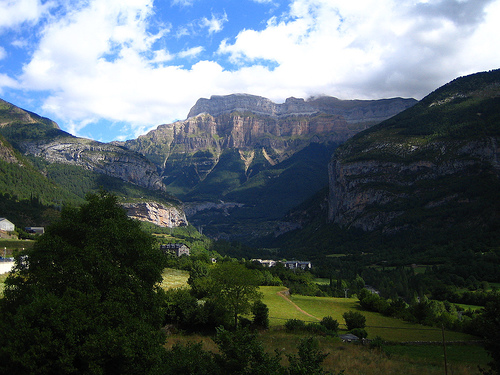

Length: 10 mi (16 km)
Area: 7,052 acres
Ordesa Valley, located in the Aragonese Pyrenees in northeastern Spain, is a stunning glacial valley within the Ordesa y Monte Perdido National Park in the province of Huesca. Spanning approximately 15 kilometers in length and reaching depths of up to 1,000 meters, it forms the heart of the park, which covers 15,608 hectares and is renowned for its dramatic U-shaped glacial landscapes, towering limestone cliffs, cascading waterfalls, and lush forests. Situated at coordinates around 42°38′N 0°03′E, the valley is dominated by Monte Perdido (3,355 meters), the third-highest peak in the Pyrenees, and is part of a UNESCO World Heritage Site (since 1997) and Biosphere Reserve (since 1977), highlighting its exceptional geological and ecological value. Often described as one of Europe's most beautiful valleys, Ordesa attracts over 500,000 visitors annually for its hiking trails, biodiversity, and pristine natural beauty, offering a blend of alpine scenery reminiscent of the Grand Canyon but on a more intimate scale. The valley's name derives from the Aragonese word for "bear," reflecting its wildlife heritage, and it serves as a gateway to exploring the broader Pyrenean ecosystem.
Human presence in Ordesa Valley dates back to prehistoric times, with
evidence of Paleolithic settlements and cave art in nearby sites within
the Vero River Cultural Park. During the Moorish period (8th-11th
centuries), the area was part of the Muslim frontier, but it remained
largely uninhabited due to its rugged terrain. The valley gained
strategic importance during the Reconquista, when Christian kingdoms
pushed southward; by the 11th century, it was under Aragonese control.
In the Middle Ages, shepherds and hunters used the high pastures, but
systematic exploration began in the 19th century with Romantic travelers
like Lucien Briet, who documented its waterfalls and canyons.
The
modern history of protection started in 1918, when Ordesa became Spain's
first national park, declared by King Alfonso XIII to preserve its
landscapes from logging and hydroelectric threats. Expanded in 1982 to
include Monte Perdido and adjacent valleys, it now encompasses four
sectors: Ordesa, Añisclo Canyon, Escuaín Gorges, and Pineta Valley.
UNESCO recognitions followed: Biosphere Reserve in 1977 and World
Heritage Site in 1997 for its outstanding universal value in geology and
biodiversity. The park has faced challenges like wildfires and
overtourism, leading to sustainable management practices, including
shuttle services since the 1990s to reduce vehicle impact. Today, it
symbolizes Spain's commitment to conservation, with ongoing efforts to
balance tourism and preservation.
Ordesa Valley's geology is a showcase of glacial and karst processes
from the Quaternary period, forming its iconic U-shaped profile through
ice erosion over millions of years. The valley is carved from limestone
and flysch rock, creating sheer cliffs up to 1,000 meters high, deep
gorges, and karst features like sinkholes and underground rivers. Monte
Perdido, a massif of sedimentary layers, towers at 3,355 meters, with
glaciers (now shrinking due to climate change) and cirques adding to the
alpine drama. The Arazas River flows through the valley, feeding
numerous waterfalls, including the 70-meter Cola de Caballo (Horse's
Tail).
Altitudes range from 700 meters at the valley floor to over
3,000 meters, creating microclimates from Mediterranean at lower
elevations to subalpine at higher ones. Geological highlights include
the Tozal del Mallo viewpoint and the layered strata revealing millions
of years of tectonic history from the Hercynian and Alpine orogenies.
The park's diverse relief—valleys, canyons, and plateaus—makes it a
geologist's paradise, with ongoing studies on erosion and climate
impacts.
Ordesa Valley boasts exceptional biodiversity, with over 1,400 plant
species—about 10% of Spain's flora—adapted to its varied altitudes and
climates. Lower valleys feature beech, oak, and pine forests,
transitioning to black pines, firs, and high-alpine meadows with
edelweiss, gentians, and orchids. Endemics like the Pyrenean saxifrage
thrive in rocky crevices, while spring wildflowers create vibrant
displays.
Fauna includes around 65 mammal species, such as the
reintroduced brown bear (with a small population), Pyrenean chamois,
wild boars, and red deer. Birdlife is rich with over 170 species,
including golden eagles, bearded vultures (lammergeiers), and
wallcreepers. Reptiles like the Pyrenean brook salamander and amphibians
inhabit streams, while invertebrates support the ecosystem. Conservation
efforts focus on protecting endangered species amid climate change
threats, with the park serving as a key habitat in the Pyrenees.
Ordesa Valley's attractions revolve around its natural wonders, with
hiking as the primary activity. Key sites include the Cola de Caballo
waterfall, accessible via a 17 km round-trip trail from Pradera de
Ordesa, passing beech forests and cascades like Gradas de Soaso. The
Faja de Pelay ledge trail offers panoramic views along cliff edges, a
moderate 12 km loop with 600 meters elevation gain. Advanced hikers
tackle the Monte Perdido ascent (challenging, requiring gear) or the
multi-day GR-11 traverse.
Other trails: The Senda de los Cazadores
(Hunters' Path) for vertigo-inducing views; Añisclo Canyon for deep
gorges; and Escuaín for birdwatching. Attractions also include
viewpoints like Mirador de Calcilarruego and cultural sites in nearby
Torla-Ordesa village. Non-hiking options: Scenic drives or short walks
for families.
Access Ordesa Valley primarily from Torla-Ordesa, with shuttle buses
(April-October, €4.50 round-trip) restricting private vehicles to
protect the environment. The park is open year-round, but summer
(June-September) is peak season with mild weather (10-25°C); winter
brings snow for cross-country skiing, though some trails close. Entry is
free, but permits are needed for certain activities like climbing.
Visitor centers in Torla and Escalona provide maps and info.
Tips: Book shuttles in advance during high season; wear sturdy boots and
pack water/weather gear, as conditions change rapidly. Follow "Leave No
Trace" principles—no pets on trails, stay on paths to avoid erosion.
Accommodations range from campsites to hotels in Torla; nearby Huesca
Airport (2-hour drive) or Zaragoza (3 hours) for access. Official
website: www.aragon.es (park section) for updates.